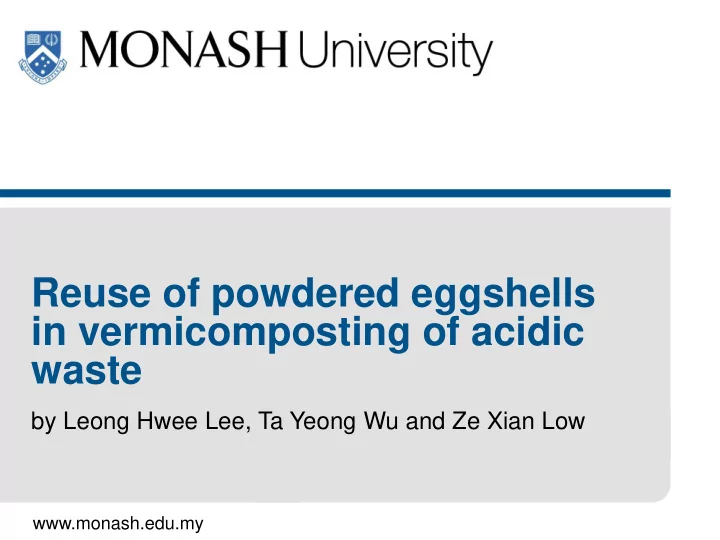

Reuse of powdered eggshells in vermicomposting of acidic waste by Leong Hwee Lee, Ta Yeong Wu and Ze Xian Low www.monash.edu.my
Content of Today’s Presentation Introduction Materials and Methods Results and Discussion a) pH b) C/N ratio c) Electrical conductivity Conclusion www.monash.edu.my Slide 2
Introduction Vermicomposting – Biological decomposition of organic waste to produce vermicompost via interactions between earthworms (epigeic) and microorganisms. www.monash.edu.my Slide 3
Introduction Advantages of vermicomposting process (Singh et al., 2011; Lim et al., 2016): • Short Processing time. • High nutrients recovery. • Texture of vermicompost is finer and heavy metals accumulated in earthworm bodies. Disadvantage of vermicomposting process (Lim et al., 2016): • Organic waste must NOT be hard, oily, acidic and alkaline. www.monash.edu.my Slide 4
Materials and Methods 60 days Eudrilus eugeniae Acidic waste: Orange skin pH pH: 4.37 C/N ratio Alkaline waste: Eggshells pH: 10.03 Electrical conductivity Amendment: Soil pH~ 5.50 www.monash.edu.my Slide 5
Materials and Methods Table 1: Description of different treatments used in vermicomposting experiment Treatment Treatment description S Soil only (as experimental control) 1OS: 1ES: 1S 1 part of orange skin: 1 part of eggshells: 1 part of soil 1.5OS: 1.5ES: 1S 1.5 part of orange skin: 1.5 part of eggshells: 1 part of soil 2OS: 2ES: 1S 2 parts of orange skin: 2 parts of eggshells: 1 part of soil www.monash.edu.my Slide 6
OS: Orange skin Results and Discussion ES: Eggshells S: Soil Optimum initial pH range: 5-8 (Lim et al., 2016) Higher pH (8.7-9) was due to: 1. Reduction of organic acids (Lim and Wu, 2016). 2. Intensive mineralization of nitrogen by microbes (Lim et al., 2014). Fig. 1 pH in different treatments www.monash.edu.my Slide 7
OS: Orange skin Results and Discussion ES: Eggshells S: Soil Lower final C/N ratio(24.0- 59.3) was due to: 1. Organic compounds was transformed into CO 2 (Lim and Wu, 2016). 2. Production of mucus and nitrogen excrement (Lim et al., 2014). Fig. 2 C/N ratio in different treatments www.monash.edu.my Slide 8
OS: Orange skin Results and Discussion ES: Eggshells S: Soil Changes in electrical conductivity (EC) was due to: 1. Reduction of EC - stabilization of the mixtures (Kaur et al., 2010) and decomposition of organic acids (Shak et al., 2014). 2. Increase of EC – Release of minerals in the form of cations (Lim et al., 2014). Fig. 3 Electrical conductivity in different treatments www.monash.edu.my Slide 9
OS: Orange skin Conclusion ES: Eggshells S: Soil • Orange waste (Acidic waste) + eggshells (Alkaline waste) and soil (Amendment) could be used as waste mixtures (2OS:2ES:1S) in vermicomposting process. • Vermicomposting > 60 days: Better quality of vermicompost could be obtained. www.monash.edu.my Slide 10
THANKS www.monash.edu.my Slide 11
Parameter Orange skin Eggshell Soil pH 4.37 10.03 5.50 Electrical conductivity (µS cm -1 ) 1779 80.7 218 TC (g kg -1 ) 295.73 160.11 643.20 TKN (g kg -1 ) 6.750 3.375 6.000 C/N ratio 43.81 47.44 107.20 Note: Eggshell contains CaCO 3 : CaCO 3 (s) + 2H + (aq) → Ca 2+ (aq) + CO 2 (g) + H 2 O (l) www.monash.edu.my Slide 12
Recommend
More recommend